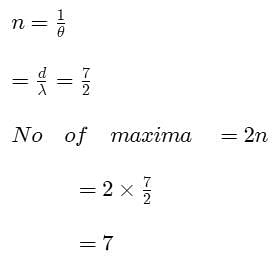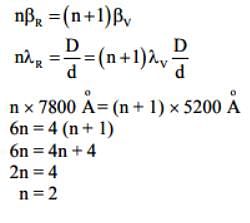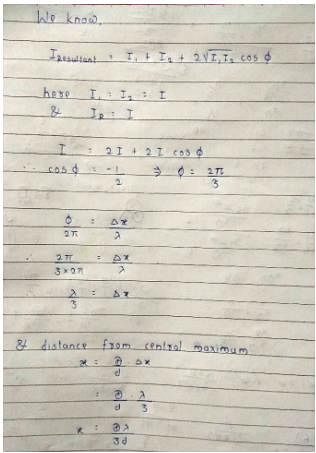Test: Waves - NEET MCQ
30 Questions MCQ Test Physics Class 11 - Test: Waves
The path difference between two wavefronts emitted by coherent sources of wavelength 5460 Å is 2.1 micron . The phase difference between the wavefronts at that point is _
| 1 Crore+ students have signed up on EduRev. Have you? Download the App |
The path difference between two waves
y1= A1 sin wt and y2= A2 cos (wt + f) will be
y1= A1 sin wt and y2= A2 cos (wt + f) will be
The resultant amplitude in interference with two coherent source depends upon _
The equation for two waves obtained by two light sources are as given below :
y1= A1 sin 3wt, y2 = A2 cos (3wt + p/6). What will be the value of phase difference at the time t _
Two coherent sources have intensity ratio of 100 : 1, and are used for obtaining the phenomenon of interference. Then the ratio of maximum and minimum intensity will be _
Two independent monochromatic sodium lamps can not produce interference because
Figure, shows wave fronts in still water, moving in the direction of the arrow towards the interface PQ between a shallow region and a deep (denser) region. Which of the lines shown may represent one of the wave fronts in the deep region ?
Two coherent monochromatic light beams of intensities I and 4I are superposed. The maximum and minimum possible intensities in the resulting beam are:
In Young's double slit experiment 62 fringes are visible in the field of view with sodium light (l = 5893Å). If green light (l = 5461Å) is used then the number of visible fringes will be _
In Young's double slit experiment, the distance of the n-th dark fringe from the centre is _
If the yellow light is replaced by the violet light then the interference fringes-
If the path difference between the interfering waves is nl, then the fringes obtained on the screen will be
The fringe width in a Young's double slit experiment can be increased. If we decrease
In young's double slit experiment, interference pattern is observed on the screen L distance apart from slits, average distance between adjacent fringes is x and slits separation is d, then the wavelength of light will be _
Plane microwaves from a transmitter are directed normally towards a plane reflector. A detector moves along the normal to the reflector. Between positions of 14 successive maxima, the detector travels a distance 0.14 m. If the velocity of light is 3 × 108 m/s, find the frequency of the transmitter.
In YDSE how many maxima can be obtained on the screen if wavelength of light used is 200nm and d = 700 nm.
In Young's double slit experiment, the wavelength of red light is 7800 Å and that of blue light is 5200 Å. The value of n for which nth bright band due to red light coincides with (n + 1)th bright band due to blue light, is
If the Young's double slit experiment is performed with white light, then which of the following is not true
Two identical narrow slits S1 and S2are illuminated by light of wavelength l from a point source P. If, as shown in the diagram above the light is then allowed to fall on a screen, and if n is a positive integer, the condition for destructive interference at Q is that
In a Young's double slit experiment, a small detector measures an intensity of illumination of I units at the centre of the fringe pattern. If one of the two (identical) slits is now covered, the measured intensity will be
In a young double slit experiment D equals the distance of screen and d is the separation between the slit. The distance of the nearest point to the central maximum where the intensity is same as that due to a single slit, is equal to
A beam of light consisting of two wavelength 6300 Å and l Å is used to obtain interference fringes in a Young's double slit experiment. If 4th bright fringe of 6300 Å coincides with 5th dark fringe of l Å, the value of l (in Å) is
|
98 videos|388 docs|105 tests
|
























